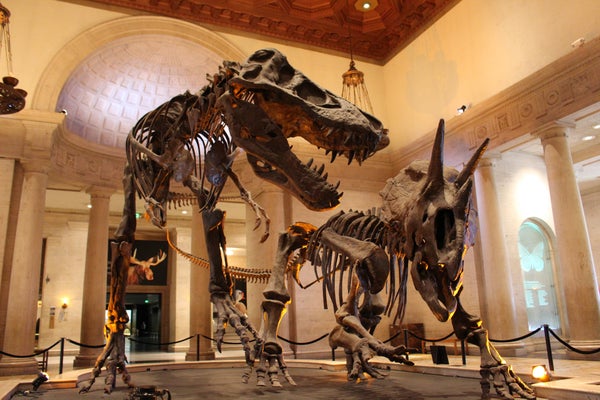This article was published in Scientific American’s former blog network and reflects the views of the author, not necessarily those of Scientific American
“I’m the best at what I do. But what I do isn’t very nice.” So said Wolverine. It just as readily applies to the biggest and ferocious of predatory dinosaurs, too. The likes of Tyrannosaurus and Giganotosaurus have taken up the role of superpredators in our imagination, skillfully able to stalk, kill, and consume more or less anything they wanted. Their carnivorous prowess is unquestionable. That’s why it’s important to question it.
The thought’s been nagging at the back of my mind ever since I chatted with paleontologist Michael Habib about the arms of Allosaurus. Yes, yes, we all ridicule the little, two-clawed nubs of Tyrannosaurus, but it was actually the forelimbs of Allosaurus and similarly-equipped theropods that make little sense. Big carnivorous dinosaurs with relatively long, sharp-clawed forelimbs probably couldn’t make much use of them while trying to nab prey. An Acrocanthosaurus or similarly-outfitted dinosaur wouldn’t be able to actually see what its arms were doing, and its jaws would most likely come into contact with prey first. Tyrannosaurus, Carnotaurus, and other puny-armed predators had it just right. Why have prominent arms that are of little use to doing the dirty work of acquiring lunch?
That question still looms, and may eventually have something to do with biological imperatives other than sinking teeth into flesh. Whatever the answer, though, it seems that big carnivorous dinosaurs were leading with their mouths. They were less like lions – cats with powerful and flexible forelimbs – and more like today’s African wild dogs and spotted hyenas. Catching or breaking down victims relied on what their jaws could achieve. And if this is right, the Mesozoic may have been gorier than traditionally depicted.
On supporting science journalism
If you're enjoying this article, consider supporting our award-winning journalism by subscribing. By purchasing a subscription you are helping to ensure the future of impactful stories about the discoveries and ideas shaping our world today.
Giant predatory dinosaurs have always been depicted as perfect killing machines. This goes all the way back to the first dinosaur ever named, Megalosaurus. Naturalist William Buckland, who named the dinosaur, didn’t have the same conception of the reptile we hold now. His was closer to an immense crocodile. But in looking at the serrated, blade-like teeth of Megalosaurus, Buckland saw the beneficence of God. In his contribution to the Bridgewater Treatises, a small library of natural theology, Buckland wrote:
In a former chapter I have endeavoured to show that the establishment of the carnivorous races throughout the animal kingdom tends materially to diminish the aggregate amount of animal suffering. The provision of teeth and jaws, adapted to effect the work of death most speedily, is highly subsidiary to the accomplishment of the desirable end.
Megalosaurus was yet another example of this, those menacing teeth offering a mercifully quick end to victims. And given that we can’t watch the “great lizard” or any other meat-eating theropod go about its work, the sentiment has stuck even after being stripped of its theological trappings. We expect that Tyrannosaurus and company were efficient, fast killers, perfectly evolved to dispatching their herbivorous neighbors.
This doesn’t square with nature. Modern carnivores, particularly ones that lead with their mouths, often leave messy kills. Great white sharks strike seals and then wait for their victims to die of catastrophic blood loss. Wild dogs and hyenas break down their prey with powerful jaws, tearing at them and even eating them alive. Crocodiles snap, roll, shake, and wrench to tear larger meals into manageable chunks. These are violent affairs that the BBC Natural History Unit prefers not to show you in their prestige programs. And I expect it would have been much the same in the Mesozoic.
Large carnivorous theropods probably had a preference for young victims. Paleontologists Dave Hone and Oliver Rauhut highlighted that this would be a way the predators of the Mesozoic acted much the same way as modern mammalian carnivores. Showdowns between carnivorous and herbivorous giants were likely rare events. But suppose that Ceratosaurus, Carcharodontosaurus, or any of the other hulking, sharp-toothed theropods tried some larger fare. There wouldn’t have been a swift bite followed by a quiet kill. The predaceous habits of these dinosaurs were more likely to have been horrific and inefficient affairs, and the frequency of injuries on some theropod skeletons – like the young Allosaurus Big Al – are consistent with the notion that it was damn hard to make a living as a carnivore. Just think of an Allosaurus trying to break down a Camarasaurus by worrying at its legs and flank, or even the mighty Tyrannosaurus trying to get the right bite to fell a struggling Edmontosaurus. It would have been a horror show. Consider that the next time you admire their jaws in a museum hall. Those gleaming teeth were not instruments of perfection to reduce the suffering of sauropods and hadrosaurs. They were ways of getting the job done by whatever means necessary.
